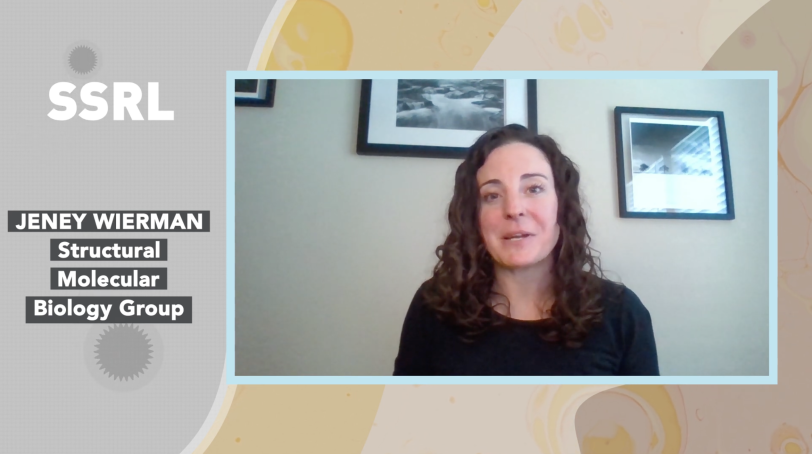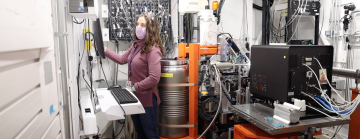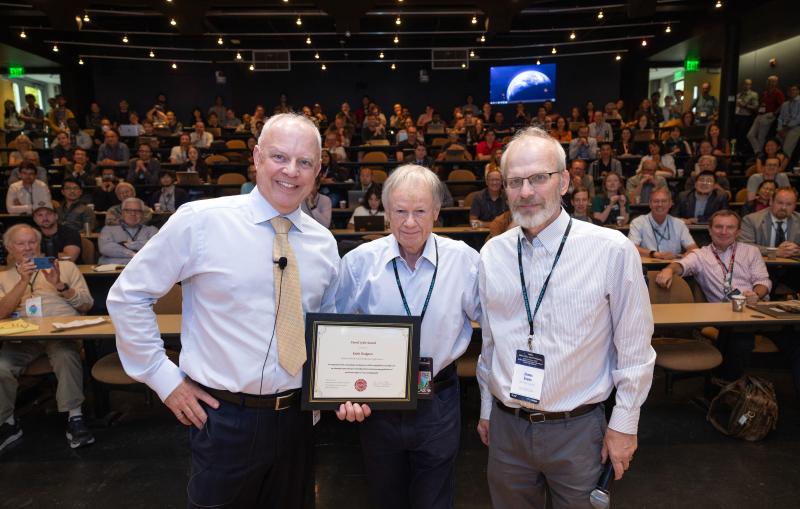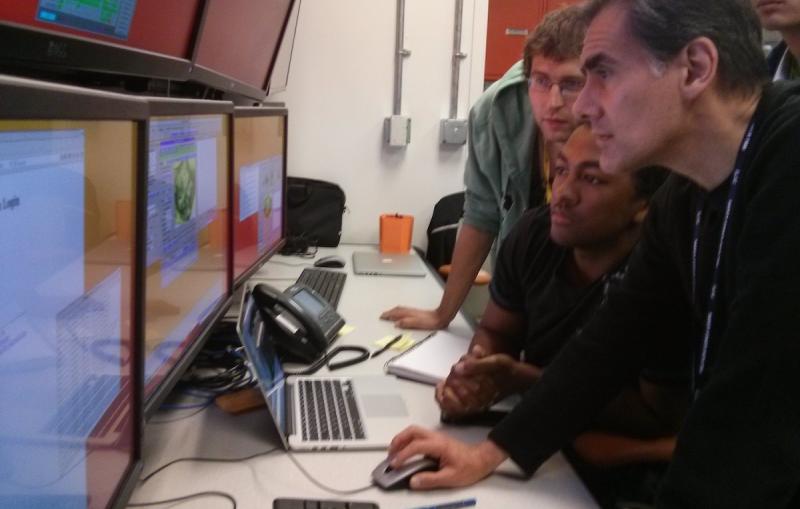SLAC’s new X-ray beamline aids COVID-19 research
Scientists are deploying this state-of-the-art X-ray crystallography facility to study biological molecules related to the COVID-19 pandemic.
There’s a new bright spot at the Stanford Synchrotron Radiation Lightsource: Beam Line 12-1, an experimental station devoted to determining the structures of biological macromolecules with high brilliance X-rays. Researchers from around the country are using it to examine the atomic structure and function of different components of SARS-CoV-2, the virus that causes COVID-19.
The new beamline at the Department of Energy’s SLAC National Accelerator Laboratory combines an extra bright, tightly focused X-ray beam with robotics, automation, full remote access and data processing systems to expand the types of macromolecules research teams can study and allow them to run experiments faster than before and from their home laboratories.
In just the first few months of operation, researchers from Stanford University, The Scripps Research Institute, the University of California, San Francisco and the California Institute of Technology have used the new beamline to study proteins thought to be central to SARS-CoV-2 infection.
Among the results are new clues about how antibodies block infection and how drugs could modulate the immune system so it responds strongly when needed while avoiding overreactions that could cause more harm than good.
The new beamline construction was funded by Stanford University, The Scripps Research Institute, several private foundations through Stanford University including the Gordon and Betty Moore Foundation, and the National Institutes of Health. In BL12-1, said Scripps Professor Ian Wilson, SSRL has one of the most advanced “microfocus” X-ray beam lines in the world. “We’ll be able to use smaller crystals, collect higher quality data, get a better signal-to-noise ratio and collect more data sets per hour” than ever before, Wilson said.
BL12-1 started user operations after the COVID-19 pandemic shelter-in-place began, said Aina Cohen, an SSRL senior scientist who directs operations at BL12-1, and as a result it has done almost entirely COVID-related research so far, including a number of studies from Wilson’s group. But as the shelter-in-place starts to lift, other projects will start to come in, she said, “and they will also benefit from using the advanced capabilities of BL12-1.”

SSRL X-Ray Crystallography Covid-19 Research
Jeney Wierman, a staff scientist at SLAC, explains how SSRL tools are contributing to COVID-19 research.
Olivier Bonin/SLAC National Accelerator Laboratory
Going big with smaller beams
One of BL12-1’s key features is its very small beam size, with a 5 micron vertical focus, and high brightness relative to other beamlines devoted to structural molecular biology and X-ray macromolecular crystallography. The small, intense beam will come in particularly handy when studying molecules for which it’s difficult or time-consuming to grow large crystals – in general, it’s easiest to extract useful information when the beam size is on par with the size of the crystal itself.
This small beam size has already proven very important for COVID-19 research, said Christopher Barnes, a postdoctoral fellow in Pamela Bjorkman’s group at Caltech. Barnes is studying the structure of SARS-CoV-2 antibodies, including how and where they bind to the virus — and he’s trying to do it as fast as he can.
“Because of the speed of these projects, we didn’t make the crystals as uniform as we usually do,” Barnes said, so they needed a beam that can focus in on smaller, more even patches within the crystals. “That is only achievable with a microfocus beamline like BL12-1,” he said.
In addition, BL12-1 features new, faster data collection systems, robotics that remotely switch out samples and experimental setups faster than before, and the ability to carry out serial crystallography, in which very small crystals are shot into the beam one after the other, giving researchers a full picture of the proteins within those crystals without the need to grow a single, larger one. What’s more, all of this can be carried out remotely from the users’ home laboratories, an important benefit during this period of limited travel and social distancing.
Speed and flexibility in the time of coronavirus
The startup of the new beamline faced an unusual hurdle: Work on it largely came to a halt after shelter-in-place orders went into effect, and much of the final testing wasn’t completed until April. Even then, there were tight restrictions on the number of personnel who could come to the lab to complete work on beamline hardware and to test systems, so the first commissioning experiments – studies run in part to work out any kinks in the system – were related to the novel coronavirus.
One early experiment, led by UCSF Professor James Fraser, used BL12-1’s capacity to examine samples that are not frozen but at room temperature to study enzymes involved in viral replication closer to body temperatures. Another – one of the first to run on BL12-1 – was a study, recently published in Science by Wilson and colleagues, of the molecular structures of antibodies that the immune system uses to block SARS-CoV-2 from infecting cells.
“It’s fantastic that we’ve been able to use this beamline while it’s being commissioned and actually accelerate our progress on COVID-19 work,” Wilson said.
Stanford Professor Jennifer Cochran, graduate student Jack Silberstein and SSRL scientist Irimpan Mathews took a different approach. They are searching for drugs that could modulate the immune system’s response up or down depending on what phase of the disease a patient is in — up early on, and down if there are signs of an immune overreaction. Knowing the structures of both the drugs and the immune-system molecules they act on is essential to the search, Silberstein said: “If you don’t have a structure, you’re flying blind.”
Mathews said that BL12-1’s small, high intensity beam helped them target specific parts of their crystals and collect different data sets from the same crystals, speeding their work. “I was surprised by how smooth our measurements were,” he said.
Starting up when sheltering in place
Having a steady stream of users like these, Cohen said, helped to work out any remaining kinks during the commissioning phase, particularly since so much work had to be done remotely.
“Only one or two members of our research team were allowed on site at a time and all the user groups connected to our systems remotely to control their experiments," she said. "Much of the troubleshooting work could be done remotely by our programmers and support scientists. In other cases, we would have a lot of people at home advising the person on site,” and SSRL team members rotated in and out, some working night and weekend shifts to make it work while maintaining physical distancing. “That, combined with our fully automated and remote-controlled experimental systems, gave us a lot of flexibility.”
The COVID work is continuing, starting with more projects from Scripps. Meng Yuan, a postdoctoral associate in Wilson’s group, said they are expanding their initial work to look at additional pairs of antibodies and viral proteins. “We have a large number of crystals to be screened and urgent need for beamtime,” he said. “The good capacity, fast response, and flexibility of Beam Line 12-1, along with remote access, have really helped our research.”
Extraordinary SSRL operations were supported in part by the DOE Office of Science through the National Virtual Biotechnology Laboratory, a consortium of DOE national laboratories focused on response to COVID-19, with funding provided by the Coronavirus CARES Act. SSRL is a DOE Office of Science user facility. The Structural Molecular Biology Program at SSRL is supported by the DOE Office of Science and by the National Institutes of Health, National Institute of General Medical Sciences.
For questions or comments, contact the SLAC Office of Communications at communications@slac.stanford.edu.
SLAC is a vibrant multiprogram laboratory that explores how the universe works at the biggest, smallest and fastest scales and invents powerful tools used by scientists around the globe. With research spanning particle physics, astrophysics and cosmology, materials, chemistry, bio- and energy sciences and scientific computing, we help solve real-world problems and advance the interests of the nation.
SLAC is operated by Stanford University for the U.S. Department of Energy’s Office of Science. The Office of Science is the single largest supporter of basic research in the physical sciences in the United States and is working to address some of the most pressing challenges of our time.





